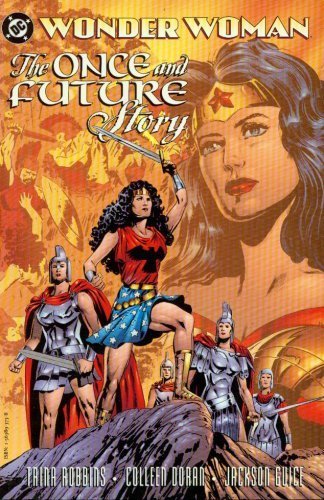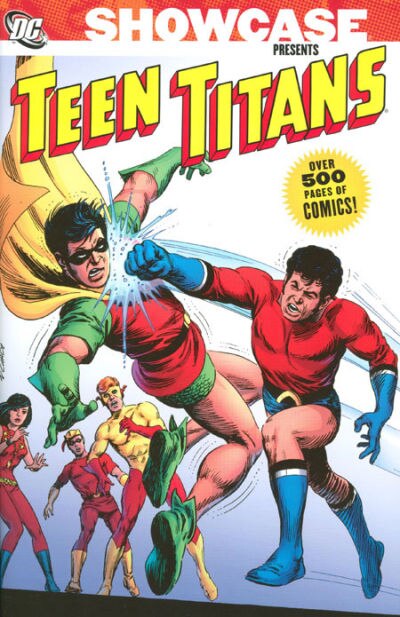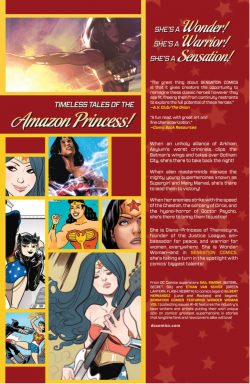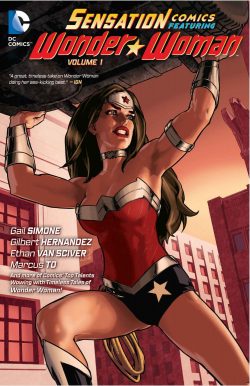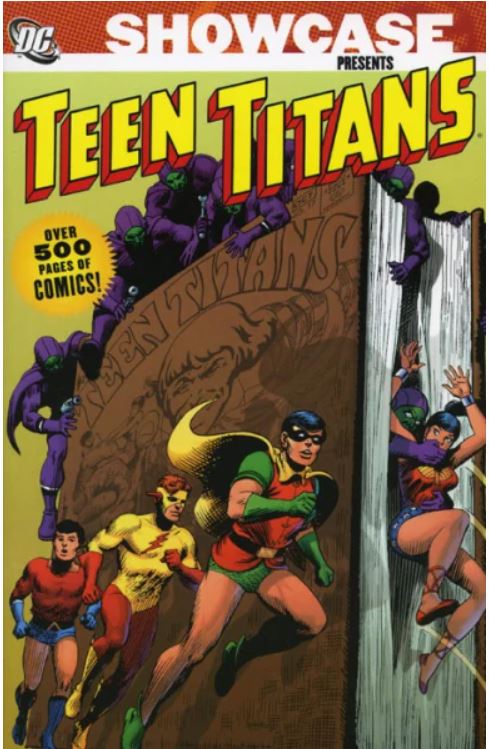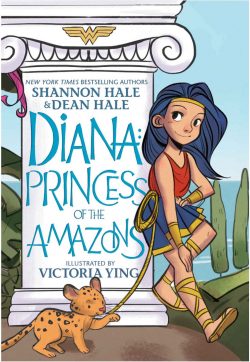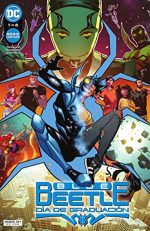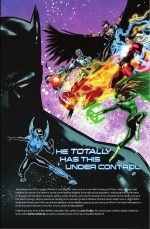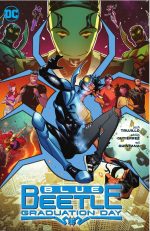
By William Moulton Marston & Harry G. Peter, Robert Kanigher, Dennis O’Neil, Roy Thomas, Greg Potter, George Pérez, William Messner-Loebs, Eric Luke, Phil Jimenez, Greg Rucka, Darwyn Cooke, Brian Azzarello, Gail Simone, Amy Chu, Ross Andru & Mike Esposito, Mike Sekowsky, Don Heck, Gene Colan, Jill Thompson, Mike Deodato Jr., Yanick Paquette, Matt Clark, Drew Johnson, J. Bone, Cliff Chiang, Ethan Van Sciver, Bernard Chang & various (DC Comics)
ISBN: 978-1-4012-6512-0 (HB/Digital edition)
Wonder Woman is the very acme of female icons. Since her debut in 1941 she has grown to permeate every aspect of global consciousness and become not only a paradigm of comics’ very fabric but also a symbol to women everywhere. Whatever era you choose, the Amazing Amazon epitomises the eternal balance between Brains & Brawn and, over those decades, has become one of that rarefied pantheon of literary creations to achieve meta-reality.
The Princess of Paradise Island originally debuted as a special feature in All Star Comics #8, conceived by psychologist and polygraph pioneer William Moulton Marston and illustrated by Harry G. Peter, in a calculated attempt to offer girls a positive and forceful role model and, on forward-thinking Editor M.C. Gaines’ part, to sell more funnybooks to girls. Immediately catapulted into her own series and cover-spot of new anthology Sensation Comics one month later, she was an instant hit. Wonder Woman won an eponymous supplemental title a few months later, cover-dated summer 1942, enabling the Star-Spangled Siren to weather the vicissitudes of the notoriously transient comic book marketplace and survive the end of the Golden Age of costumed heroes beside Superman, Superboy, Batman and a few lucky hangers-on who inhabited the backs of their titles.
This stunning compilation – part of a dedicated series introducing and exploiting the historical and cultural pedigree of venerable DC icons – offers a sequence of sublime snapshots detailing how Diana of the Amazons evolved and thrived in worlds and times where women were generally regarded as second class, second rate, painfully functional and strictly ornamental, collects material from All-Star Comics #8, Sensation Comics #1, Wonder Woman (volume 1) #7, 28, 99, 107, 179, 204, 288, Wonder Woman (vol. 2) #1, 64, 93, 142, 177, 195, 600, Wonder Woman (vol. 3) #0, Justice League: New Frontier Special #1, Sensation Comics Featuring Wonder Woman #1 & 7 – cumulatively covering July 1940 to November 2012.
The groundbreaking appearances are preceded by a brief critical analysis of significant stages in her development, beginning with Part I: The Amazon 1941-1957 which details the events and thinking which led to her creation and early blockbusting dominance of Man’s Boy’s World…
‘Introducing Wonder Woman/(Wonder Woman Comes to America)’ originated in All-Star Comics #8, (December 1941) and Sensation Comics #1 (January 1942) respectively, revealing how, once upon a time on a hidden island of immortal super-women, US Army Intelligence aviator Steve Trevor crashes to Earth. Near death, he is nursed back to health by young, impressionable Princess Diana. Fearful of her besotted child’s growing obsession with the creature from a long-forgotten and madly violent world, Diana’s mother Queen Hippolyte reveals the hidden history of the Amazons: how they were seduced and betrayed by men but rescued by the goddess Aphrodite on condition that they forever isolate themselves from the mortal world and devote their eternal lives to becoming ideal, perfect creatures.
However, when Trevor explains the perfidious spy plot which accidentally brought him to the Island enclave and with the planet in crisis, goddesses Athena and Aphrodite order Hippolyte to send an Amazon back with the American to fight for global freedom and liberty. The Queen declares an open contest to find the best candidate and, although forbidden to compete, young closeted, cosseted Diana clandestinely overcomes all other candidates to become their emissary.
Accepting the will of the gods, the worried mother outfits Diana in the guise of Wonder Woman and sends her out to Man’s World armed with an arsenal of super-scientific and magical weapons…
The Perfect Princess gained her own series and cover-spot in new anthology title Sensation Comics a month later, with the story continuing where the introduction had left off. ‘Wonder Woman Comes to America’ sees the eager immigrant returning the recuperating Trevor to the modern World before trouncing a gang of bank robbers and briefly falling in with a show business swindler. The major innovation was her buying the identity of lovelorn Army nurse Diana Prince, elegantly allowing the Amazon to be close to Steve whilst enabling the heartsick medic to join her fiancé in South America. Even with all that going on, there was still room for Wonder Woman and Captain Trevor to bust up a spy ring attempting to use poison gas on a Draft induction centre. Typically, Steve breaks his leg and ends up in hospital again, where “Nurse Prince” can look after him…
The new Diana soon gained a position with Army Intelligence as secretary to General Darnell, further ensuring she would always be able to watch over her beloved. She little suspected that, although shallow Steve only had eyes for the dazzling Amazon superwoman, the General had fallen for the mousy but supremely competent Lieutenant Prince…
As previously mentioned, the Amazing Amazon was a huge and ever-growing hit, quickly gaining her own title in late Spring (cover-dated Summer 1942). The comic frequently innovated with full-length stories, and here ‘America’s Wonder Women of Tomorrow’ (Wonder Woman volume 1 #7, Winter 1943) offers an optimistic view of the future in an extract of a fantastic fantasy tale wherein America in 3000 AD is revealed as a true paradise.
Ruled by a very familiar Lady President, the nation enjoys a miracle supplement which has extended longevity to such an extent that Steve, Etta Candy and all Diana’s friends are still thriving. Sadly, some old male throwbacks still pine for the days when women were subservient, meaning there’s still much work for the Amazing Amazon to do. With a wry but wholesome sex war brewing (and no bears available), faithful Steve goes undercover with the rebel forces and uncovers a further startling threat…
As the Golden Age drew to a close and superheroes began to wane, Wonder Woman #28 (April 1948) debuted ‘Villainy Incorporated!’ in an epic-length tale of revenge wherein eight of her greatest enemies – Queen Clea, Hypnota, Byrna Brilyant, the Blue Snowman, Giganta, Doctor Poison, Eviless, Zara, Priestess of the Crimson Flame and The Cheetah – unite to ensure her destruction and escape from Amazonian mind-bending gulag Transformation Island, where they were being rehabilitated…
Whilst costumed colleagues foundered, Wonder Woman soldiered on well into the Silver Age, benefitting from constant revisionism under the auspices of Robert Kanigher, Ross Andru & Mike Esposito, who re-energised her for the Silver Age renaissance and beyond: a troubled period encapsulated in the briefing notes for Part II: The Princess 1958-1986…
Using the pen-name Charles Moulton, Marston had scripted all Diana’s adventures until his death in 1947, whereupon after a period when his assistant Joye Hummel wrote the stories, Kanigher took over the writer’s role. H. G. Peter soldiered on with his unique artistic contribution until he passed away in 1958. In April of that year Wonder Woman #97 was his last hurrah and truly the end of an era.
With the exception of DC’s Trinity (plus a few then-innocuous back-up features like Green Arrow and Aquaman), superheroes all but vanished by the early 1950s, replaced by mostly mortal champions in a deluge of anthologised genre titles. Everything changed again after Showcase #4 rekindled public interest in costumed crimebusters with a new iteration of The Flash in 1956. From that moment fanciful floodgates opened wide once more, and whilst reinventing Golden Age Greats such as Green Lantern, The Atom and Hawkman, National /DC methodically updated those venerable veteran survivors who had weathered the backlash. None more so than the ever-resilient Wonder Woman…
As writer/editor Kanigher tweaked or reinvented much of the original mythos, tinkering with her origins and unleashing Diana on an unsuspecting world in a fanciful blend of girlish whimsy, rampant sexism, strange romance, alien invasion, monster-mashing and utterly surreal (some say-stream-of-consciousness) storytelling. This was at a time when all DC’s newly revived, revised or reinvented costumed champions were getting together and teaming up at the drop of a hat – as indeed was the Princess of Power in Justice League of America. However, on the pages of her own title a timeless, isolated fantasy universe was carrying on much as it always had.
Wonder Woman #99 (volume 1, July 1958) heralded a new start and introduction of the Hellenic Heroine’s newly revitalised covert cover: Air Force Intelligence Lieutenant Diana Prince, launching a decade of tales with Steve perpetually attempting to uncover her identity and make the most powerful woman alive his blushing bride, whilst the flashily bespectacled glorified secretary stood exasperated and ignored beside him. ‘Top Secret’ sees Steve trying to trick Diana into marriage – something the creep tried a lot back then – by rigging a bet with her. Of course, the infinitely patient Princess outsmarts him yet again…
Although not included here, WW #105 had introduced Wonder Girl: revealing how centuries ago the gods and goddesses of Olympus bestowed unique powers on Hippolyta’s daughter and how even as a mere teenager indomitable Diana had brought the Amazons to Paradise Island. Continuity, let alone consistency or rationality, were never as important to Kanigher as a strong story or breathtaking visuals and that eclectic odyssey – although a great yarn – simply annoyed the heck out of many fans; but not as much as the junior Amazon would in years to come…
The teen queen kept popping up and here ‘Wonder Woman – Amazon Teen-Ager!’ (#107, July 1959) sees the youngster wallowing in a new, largely unwanted romantic interest as mer-boy Ronno perpetually gets in the way of her quest to win herself a superhero costume…
As the 1960s progressed, Wonder Woman looked tired and increasingly out of step with the rest of the company’s gradually gelling – ultimately cohesively shared – continuity but, by the decade’s close, a radical overhaul of Diana Prince was on the cards.
In 1968 superhero comics were once again in decline and publishers were looking for ways to stay profitable – or even just in business – as audience tastes and American society evolved. Back then, with the entire industry dependent on newsstand sales, if you weren’t popular, you died. Handing over the hoary, venerable and increasingly moribund title to Editor Jack Miller and Mike Sekowsky, the bosses sat back and waited for their eventual failure, and prepared to cancel the only female superhero in the marketplace…
Sekowsky’s unique visualisation of the Justice League of America had greatly contributed to the title’s overwhelming success, and at this time he was stretching himself with a number of experimental projects, focussed on the teen and youth-markets. Tapping into the teen zeitgeist with the Easy Rider styled drama Jason’s Quest proved ultimately unsuccessful, but with Metal Men and hopelessly hidebound Wonder Woman, he had much greater impact. Sekowsky ultimately worked the same magic with far greater success for Supergirl in Adventure Comics (another epic and intriguing run of tales long overdue a curated compilation).
With relatively untried scripter Denny O’Neil on board for the first four tales, #179 heralded huge changes as ‘Wonder Woman’s Last Battle’ (December 1968, with Dick Giordano inking) saw the immortal Amazons of Paradise Island forced to abandon our dimensional plane. They took with them all their magic – including all Diana’s astounding gadgets and weapons like the Invisible Plane and Golden Lasso – and ultimately even her mighty powers. Despite all that, her love for Steve compelled her to remain on Earth. Effectively becoming her own secret identity of Diana Prince, the now-mortal champion resolved to fight injustice as a human would…
Sekowsky’s root & branch overhaul offered a new kind of Wonder Woman (and can be seen in a magical quartet of collections entitled Diana Prince: Wonder Woman) but, as always, fashion and reader response ruled and in a few years, with no fanfare or warning, everything that had happened since Wonder Woman lost her powers was unwritten.
Her mythical origins were revised and re-established as she abruptly returned to a world of immortals, gods, mythical monster and supervillains. There was even a new nemesis: an African/Greek/American half-sister named Nubia who debuted in ‘The Second Life of the Original Wonder Woman’ (Wonder Woman #204, February 1973, by Kanigher, Don Heck & Vince Colletta) which delivers the murder of Diana’s martial arts mentor I Ching as prelude to Diana being restored to her former glory by the returned and restored Amazons on Paradise Island…
Such an abrupt reversal had tongues wagging and heads spinning in fan circles. Had the series offended some shady “higher-ups” who didn’t want controversy or a shake-up of the status quo?
Probably not.
Sales were never great even on the Sekowsky run and despite strident public protests about depowering a strong woman from feminists like Gloria Steinem, the most rational and realistic reason is probably Television money. The Amazon had been optioned as a series since the days of the Batman TV show in 1967, and by this time (1973) production work had begun on the 1974 pilot featuring Cathy Lee Crosby. An abrupt return to the character most viewers would be familiar with from their own childhoods seems perfectly logical to me…
By the time Lynda Carter made the concept work in 1975 by going back to ancient basics, Wonder Woman was once again “Stronger than Hercules, Swifter than Mercury and More Beautiful than Aphrodite”…
Eventually however – after the TV-inspired sales boost ended with the show’s cancellation – the comic slumped into another decline, leading to another revamp.
Notionally celebrating the beginning of her fifth decade of continuous publication, Wonder Woman #288, (February 1982) saw Roy Thomas. Gene Colan & Romeo Tanghal take over, rededicating the Amazon to fighting for Love, Peace, Justice and Liberty in ‘Swan Song!’
The story features the creation by war god Mars of new villain Silver Swan – transformed from an ugly, spiteful ballerina into a radiant, spiteful flying harridan – whilst the biggest visible change was replacing the stylised eagle on Diana’s bustier with a double “W”, signifying her allegiance to women’s action group The Wonder Woman Foundation.
The Silver Age had utterly revolutionised a flagging medium, bringing a modicum of sophistication to a returning and evolving sub-genre of masked mystery men. However, after decades of cosy wonderment, Crisis on Infinite Earths transformed all of DC’s interconnected Universe, leading to a truly reimagined Wonder Woman with a different history and character as discussed and then displayed in Part III: The Ambassador 1986-2010…
Wonder Woman volume 2 #1 debuted with a February 1987 cover-date. Crafted by Greg Potter, George Pérez & Bruce Patterson, ‘The Princess and the Power’ reveals how Amazons are actually reincarnated souls of women murdered by men throughout primordial times. Given potent new form by female Hellenic gods, they thrived in a segregated city of aloof, indomitable women until war god Ares orchestrated their downfall via his demigod dupe Herakles.
Abused, subjugated and despondent, the Amazons were rescued by their guardian goddesses in return for eternal penance in isolation on hidden island Themyscira. Into that paradise Diana is born: another murdered soul, imbued with life in an infant body made from clay. She will excel in every endeavour and become the Wonder Woman…
On relocating to the outer world, Diana becomes an inspirational figure and global hero constantly trying to integrate and understand the madness of “Patriarch’s World”…
In ‘The Heart of the City’ (Wonder Woman vol. 2 #64, July 1992) Bill Messner-Loebs, Jill Thompson & Denis Rodier focus on that dilemma as Diana attempts to recover a kidnapped child used as leverage by gangsters while saving a weary, outraged but righteous cop from confusing vengeance with justice…
That struggle for understanding – and sales – led to the Princess surrendering her right to the role of Wonder Woman after losing a duel with fellow Amazon Artemis. The aftermath seen in ‘Violent Beginnings’ (Wonder Woman #93, January 1995 by Messner-Loebs & Mike Deodato Jr.) reveals how her brutal, hard-line replacement takes over her ambassadorial role in Patriarch’s World with the defeated but undaunted predecessor keeping watchful eyes on the brutal warrior in her clothes…
These years are categorised by a constant search for relevance and new direction, and in ‘The Bearing of the Soul’ (WW #142 March 1999 by Eric Luke, Yanick Paquette, Matt Clark, Bob McCloud & Doug Hazlewood) the Amazon, supplemented with incredible alien technology, declares herself a global peacekeeper, dashing to flashpoints and conflict zones to end wars and save lives, irrespective of others’ political or moral objections…
From three years later, ‘Paradise Found’ (#177, 2002, by Phil Jimenez & Andy Lanning) sees another course change as Themyscira is rebuilt following war between gods and offered to the outer world as an exemplar of Paradise on Earth and the oldest and youngest of its sometimes-united nations…
The often-hilarious downsides of ‘The Mission’ (WW #195, 2003) are explored by Greg Rucka, Drew Johnson & Ray Snyder and reiterated in a wry out-of-world vignette by Darwyn Cooke & J. Bone, teaming the Diana of 1962 with equally-pioneering female crimefighter Black Canary. ‘The Mother of the Movement’ (Justice League: New Frontier Special #1, 2008) sees the occasional sister-act confront a magazine owner and aspiring nightclub impresario over the way he makes his staff dress up like rabbits. Moreover, history fans, one of those indentured luscious lepines is an undercover reporter…
Many such minor tweaks in her continuity and adjustments to the continuity accommodated different creators’ tenures until 2011, when DC rebooted their entire comics line again and Wonder Woman once more underwent a drastic, fan-infuriating root-&-branch refit as represented here in Part IV: The Warrior 2012-2014. Possibly to mitigate the fallout, DC okayed a number of fall-back options such as the beguiling collected package under review today…
After a full year of myth-busting stories, ‘Lair of the Minotaur’ was the subject of Wonder Woman vol. 4 #0, (November 2012) wherein Brian Azzarello & Cliff Chiang puckishly explored a different history as a teenaged Princess Diana underwent trials and training and fell under the sway of a sinister god…
As an iconic figure – and to address the big changes cited above – a number of guest creators were invited to celebrate their take on the Amazon in an out-of-continuity series, and from Sensation Comics Featuring Wonder Woman #1, (2014) Gail Simone & Ethan Van Scriver’s ‘Gothamazon’ deliciously details how a mythologically militaristic Wonder Woman uncompromisingly and permanently cleans up Batman’s benighted home when the Gotham Guardians are taken out of play, whilst in Sensation Comics Featuring Wonder Woman #7, Amy Chu & Bernard Chang go out-of-world (and into ours?) to celebrate the inspirational nature of the concept of Wonder Woman.
‘Rescue Angel’ sees soldiers pinned down in Afghanistan saved by Lt. Angel Santiago. The wounded woman warrior claims her outstanding actions under fire are the result of a vision from her favourite and most-beloved comic book character…
This magical and magnificent commemoration is packed with eye-catching covers from the stories but also from unfeatured tales, by the likes of H.G. Peter, Irwin Hasen & Bernard Sachs, Sekowsky, Dick Giordano, Heck, Gene Colan, Pérez, Brian Bolland, Deodato Jr., Adam Hughes, Chiang, Van Sciver, Shane Davis & Michelle Delecki, Ivan Reis & Oclair Albert, Nicola Scott & Francis Manapul.
Wonder Woman is a primal figure of fiction and global symbol, and set to remain one. This compilation might not be all of her best material – or even up to date – but it is a solid representation of what gave her such fame and would grace any fan’s collection.
© 1941, 1942, 1943, 1948, 1958, 1959, 1968, 1973, 1982, 1987, 1992, 1995, 1999, 2002, 2003, 2008, 2010, 2012, 2014, 2016 DC Comics. All Rights Reserved.












